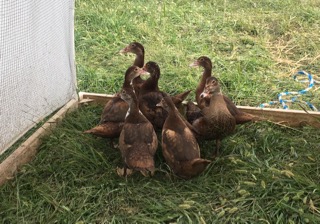 We’ve had many integrations this year: several groups of chicks as well as ducklings. Integration isn’t easy – the older animals aren’t nice to the younger ones (think freshman and seniors), and it’s new and stressful for the young ones. Eventually, though, it has to happen. The last group of ducklings has finally been integrated into the main group – hooray!
We’ve had many integrations this year: several groups of chicks as well as ducklings. Integration isn’t easy – the older animals aren’t nice to the younger ones (think freshman and seniors), and it’s new and stressful for the young ones. Eventually, though, it has to happen. The last group of ducklings has finally been integrated into the main group – hooray!
Phoebe’s 7 ducklings are the last to join the main group. They, like Coraline’s broody-raised ducklings, are more skittish than our incubated ducklings, but seemed to have a very easy assimilation into the group when we let them mingle during the day. They were quick to join in at feeding time and seemed to be subject to less “hazing” (feather grabbing by older ducks and drakes) than other juveniles we’ve integrated.
The juveniles had been spending their days in the multi-purpose (hoop) tractor, and closed up in a secure coop within the tractor at night. We started letting them out of the tractor during the day and herding them back at night. Then, one evening, after the other ducks were secured in the main duck coop, we brought the juveniles, one by one, to the main coop for the night. We listened for the telltale signs of conflict (honking, wing flapping), but all was quiet.
The next morning, everyone came down the ramp at breakneck speed (and yes, a couple typically fall of the ramp in the mad rush but are fine), but the juveniles lingered inside. After a couple of minutes, they came out and had breakfast, too.
Now, it’s difficult to identify the juveniles because they have completely assimilated with the adult group. They go into the coop at night without too much trouble, but we do occasionally have to catch one with the large net we bought specifically for catching ducks and chickens. Actually, we occasionally have to catch one of the older ducks or drakes, too – sometimes they just don’t want to go in at night. Each evening, we’re not sure if everyone will go in quietly or if it’ll be the “duck rodeo”…but that’s part of the fun!
